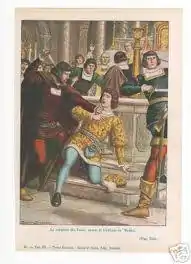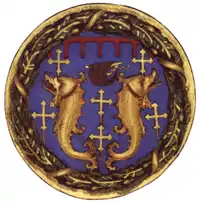Francesco de' Pazzi
Francesco de' Pazzi (28 January 1444 – 26 April 1478) was an Italian banker and one of the instigators of the Pazzi conspiracy. He, Jacopo de' Pazzi and Renato de' Pazzi were executed after the plot failed.[1]
Francesco de' Pazzi | |
|---|---|
 Francesco de' Pazzi stabbing Giuliano de' Medici | |
| Coat of arms |  |
| Born | 28 January 1444 Florence, Italy |
| Died | 26 April 1478 (aged 34) Florence, Italy |
| Noble family | Pazzi |
| Occupation | Banker |
On Sunday, 26 April 1478, in an incident known as the Pazzi conspiracy, a group headed by Girolamo Riario, Francesco de' Pazzi and Francesco Salviati attacked Lorenzo de' Medici and his brother, the co-ruler Giuliano, in the Duomo of Florence, Santa Maria del Fiore, in an attempt to seize control of the Florentine government.[2] Giuliano de' Medici was assassinated by Francesco de' Pazzi and Bernardo Baroncelli.[3] He was killed by a sword wound to the head and was stabbed 19 times.[4]
In popular culture
Francesco de' Pazzi was sung by bass Ludovico Contini in the first performance of Leoncavallo's 1893 opera I Medici.[5][6]
He is a character in the video game Assassin's Creed II and is voice acted by Andreas Apergis,[7] where he has a son named Vieri, who appears also in Assassin's Creed: The Ezio Collection.[8] Both characters are killed by the series protagonist Ezio Auditore da Firenze.
Elliot Levey portrayed Francesco de' Pazzi in TV series Da Vinci's Demons.[9]
Francesco is referenced in the movie Hannibal where Hannibal Lecter meets a modern day relative, Chief Inspector Rinaldo Pazzi. Rinaldo tries to capture Hannibal as part of large reward, however he meets a similar fate to his predecessor. He appears in the second season of Medici: Masters of Florence, played by Matteo Martari.[10]
References
- Hibbert, Christopher (6 December 2001) [1 January 1974]. The Rise and Fall of the House of Medici. Harmondsworth, Middlesex: Penguin UK. p. 141. ISBN 0140050906.
- Jensen, De Lamar (1992). Renaissance Europe: Age of Recovery and Reconciliation (2nd ed.). Lexington, Massachusetts: D. C. Heath and Company. p. 80. doi:10.2307/3167078. ISBN 9780669200072. OCLC 25171924.
- Smedley, Edward; James, Hugh James; Rose, Henry John (1845). Encyclopaedia Metropolitana; Or, Universal Dictionary of Knowledge on an Original Plan Comprising the Twofold Advantage of a Philosophical and an Alphabetical Arrangement, with Appropriate Engravings. B. Fellowes. p. 272.
- Koestler-Grack, Rachel A. (1974). Joseph, Michael (ed.). Leonardo Da Vinci: Artist, Inventor, and Renaissance Man. Infobase Publishing. p. 152. ISBN 978-0791086261.
- Casaglia, Gherardo (2005)."I Medici, 9 November 1893". L'Almanacco di Gherardo Casaglia (in Italian).
- Farr, Robert J. (August 2010). "Review – Leoncavallo – I Medici". MusicWeb International. Retrieved 30 August 2010.
- Castaño Ruiz, Clara (18 October 2015). "Assassin's Creed: 10 momentos históricos de la saga". Hobby Consolas (in Spanish). Retrieved 9 May 2018.
- Makedonski, Brett (14 November 2016). "The Ezio Collection represents some of the best and the worst for Assassin's Creed". Destructoid. Retrieved 9 May 2018.
- Hale, Mike (11 April 2013). "The He-Man Who Gave Mona Lisa That Smile". The New York Times. The New York Times Company. Retrieved 9 May 2018.
- Spencer, Samuel (26 January 2019). "Medici family tree: How are the new characters related to season 1?". Daily Express. Retrieved 26 February 2019.
External links
 Media related to Francesco de' Pazzi at Wikimedia Commons
Media related to Francesco de' Pazzi at Wikimedia Commons